Archive for ‘NAPO Conference’ Category
NAPO2018: Advancing at a Retreat

As I write this post, I’m counting down the hours until I head to suburban Chicago for NAPO 2018. From 2002 through 2017, I had the pleasure of attending my industry’s NAPO Conference and Expo each year. 2018, however, has brought quite a few new developments.
First, we’ve changed our name! We’re still NAPO, but our full name has changed from the National Association of Professional Organizers to the National Association of Productivity and Organizing Professionals. While personal and professional productivity (say that three times quickly!) has always been a huge part of the organizing process, it’s taken many decades to give that side of what we do the name-value attention it deserves.
Second, we’re learning not to hide our light under a bushel (because piling things atop other things just leads to clutter). Instead, we’ve been spreading the word about organizing far and wide. For example, you may have seen our current president (and my NAPO 2015 conference roommate) Ellen Rubin Delap and some of our colleagues on CBS Sunday Morning this past weekend, talking about why people are so greatly in need of organizing assistance and what we can do to help.
I’ve been trying to spread the word, too, such as with my guest post for the NAPO Get Organized blog, entitled In Checkbooks and Underwear Drawers: What Certified Professional Organizers Offer Our Clients. The goal was to make sure that everyone (the public, the media, aspiring professional organizers, veterans, etc.) understands why we professional organizers (including CPOs, like me) do what we do: for you, the client. We recognize the vulnerability you share when inviting us into your homes and offices, and we want to honor you with respect.
Third, at least for this year, our conference structure is changing. There’s no expo. That means that Paper Doll won’t be frantically running around the expo floor in order to learn about every new product on display. (Never worry, readers. This just means that I’ll be spending more time independently investigating the great organizing products on the horizon. If your company makes something novel in support of organizing or productivity, be sure to use the contact page to let me know about it!)
I should note while there is no formal expo, two of our beloved NAPO business partners will be in attendance as conference sponsors. So, I’m looking forward to seeing our friends at Smead, the source of so many past post-conference product reviews, and Brother, from whom I just bought my new laser printer for Paper Doll HQ, and from whom I’m hoping to learn more about the Cube, their Bluetooth-connected label printer.
Fourth, and finally, this year’s conference is envisioned as a retreat, with more focus on self-care, not just so that we professional organizers can balance our lives, but so that we can better help our clients achieve balance.
Sure, we’ve got our traditional educational workshops on ADHD, space planning, chronic disorganization, Quickbooks efficiency, and the myths surrounding multitasking. But this year’s conference has a real focus on the robust emotional side of what we do and what our clients need, with topics ranging from silencing self-doubt and creating better boundaries, to improving self-care (with a focus on better sleep), to Buddhist principles and “Yogic tools” for organizers needs. Gracious!
A retreat brings to mind a spa-like experience, and in addition to our classroom experiences, we’ll have opportunities to participate in yoga, learn belly dancing, and embrace mindfulness. I also always like the duality of the term “retreat” — it’s about taking a step back from the busy hum of everyday life, but it’s also a possibility to advance — advance my knowledge, my skills, and my ability to help readers and clients.
It doesn’t hurt that the conference/retreat is being held at the Q Center in St. Charles, Illinois. Not too shabby, eh?

I look forward to reporting to you on this year’s conference retreat. Until then, feel free to type “NAPO” or “expo” in the search box on the left side of my site to revel in the products and experiences of past NAPO conferences.
Paper Doll’s NAPO 2017 Recap: A Sneak Peak at Smead’s All-in-One® Organizer Kits
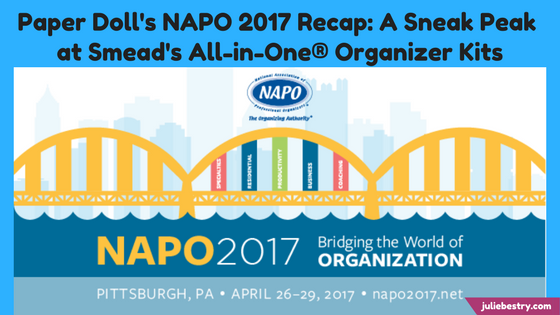
Paper Doll doesn’t like to play favorites, but it’s hard not to love a company whose heart and soul is helping you keep your paper organized, so we have more than a few post’s worth of post-NAPO2017 news from our friends at Smead. Today, we’re looking at their direct-to-consumer line, myOrganized.life, designed to help you keep your personal and family documents safe, secure, accessible, and organized. But Smead’s NAPO Expo showing was bountiful, so watch upcoming posts for some nifty innovations.
###
In an emergency, could you find your will? Your Power of Attorney documents? Your life insurance policy? Approaches to general filing systems vary. Some people have very specific, well-labeled, color-coded filing systems that they maintain religiously. Others have one drawer for important documents and one hip-high “stack” earmarked for paid bills, and assuming no strong gust of wind (or a playful puppy or child) gets near, they’re satisfied. Most people, and especially most of my clients, fall somewhere in the middle of the spectrum.
DIY vs. Made-For-You Filing Systems
Often, what holds people back from developing filing systems is perfectionist procrastination. Rather than creating a wrong system, they won’t get started at all. Others, fearful that their system isn’t good enough (measured against some arbitrary benchmark or guideposts), up-end their files and folders and binders, starting from scratch every few months or years, not because their system wasn’t working, but because they’d never committed to it in the first place, and the appeal of a magical solution was more compelling than the reality of having to make decisions and apply rules.
It’s not as though there aren’t multiple ways to contain papers and documents — we have tabbed file folders, hanging folders, ringed binders, accordion-style folders — and they are all fine, depending on your resources, your space, and your willingness to maintain your system. By and large, there is no wrong system — as long as the system works for you!
Longtime readers of this blog know that Paper Doll isn’t going to drink the Koolaid and tell you that you have to buy a pre-existing filing system with pre-made categories, like FreedomFiler. I have many colleagues who love, respect, and recommend that particular pre-made, “self-purging” filing system, with the categories all laid out, and even year/odd year purging and shredding schedules. I see the value, but unless one of my clients asks for something like that during our sessions, it’s my professional experience that people with disorganized (or non-existent) filing systems learn more when, together, we create their entire filing system from scratch. This way, clients learn the why behind the what and the how. I think naming each file something that works for you (Vet: Fluffy vs. Medical: Cat, or Elantra vs. Auto vs. Car vs. Roxanne) helps inspire you to actually file your documents away.
That said, most people don’t have the opportunity (or haven’t taken the opportunity) to work with a professional organizer to get their papers in order, so if people are in a situation where “they don’t know what they don’t know” and don’t have a sense of all the documents they should be creating, collecting, and organizing, a pre-ordained system template can eliminate confusion and stress. For my clients (and readers of this blog), my Family Files approach generally works well as a starting point for getting the whole kit and caboodle in order.
- Family Filing—As easy as (eating) pie
- Financial Filing—Scrapbooking snapshots of your money’s life
- Mom, why is there a receipt stuffed in the turkey?
- I Fought the Law…and the Paperwork Won!
- Patient: “Doctor, it hurts when I do this.” Doctor: “Then don’t do that!”
- Paper Dolls Live In Paper Households
- I Hope Nobody Ever Writes a Nasty Tell-All Called “Paper Doll Dearest”!
It’s one thing to try to finesse an entire system to pay your bills, and track your daughter’s orthodontia plan, and keep your life running, but sometimes, you want to make sure that your super-essential information is available in case of an emergency. Friend-of-the-blog John Hunt, Smead’s Senior Manager of Digital Marketing and host of the Keeping You Organized video podcast, has written previously about the emotional and financial pitfalls of not having essential records available when necessary.
Life Documents Organizer
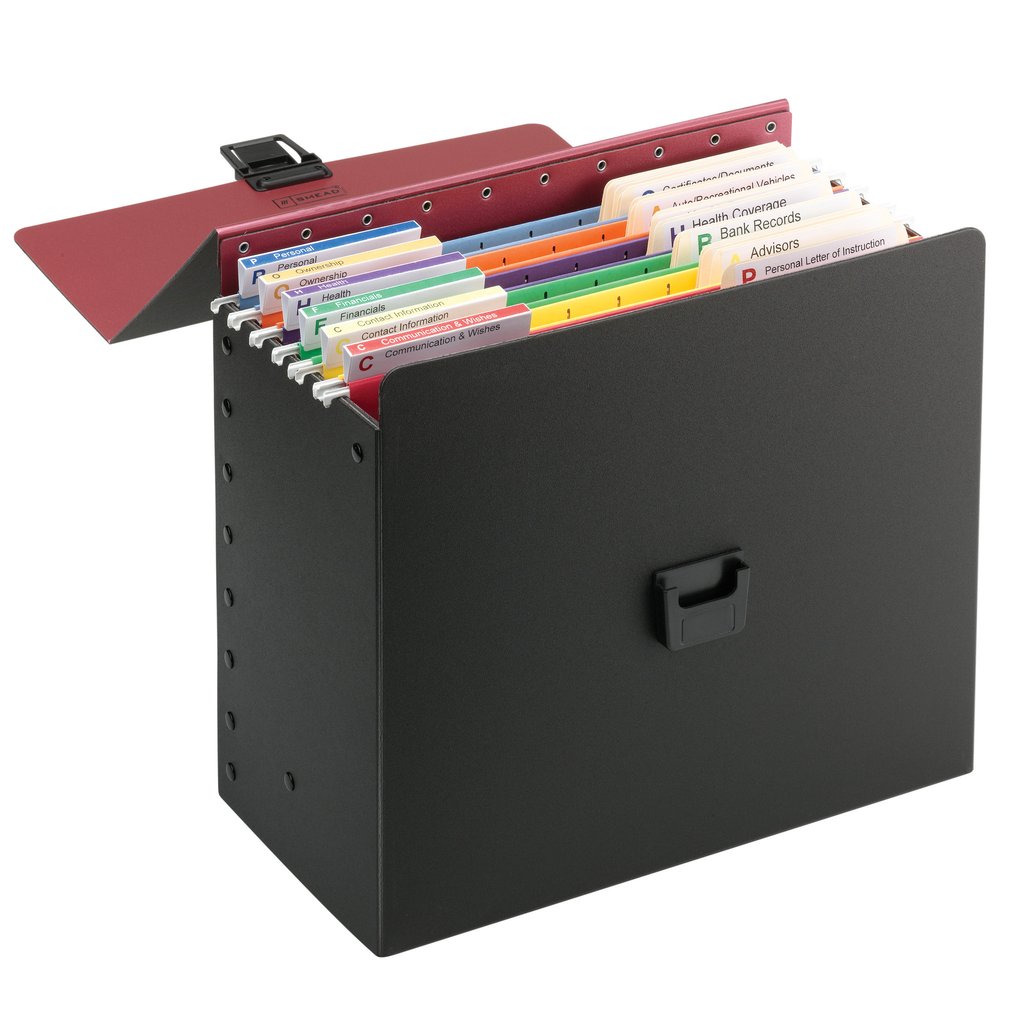
A few years ago, Smead launched its own self-contained filing system called the Life Documents Organizer to help consumers organize and store what they call “key life documents” — what Paper Doll refers to as VIPs (very important papers). These include wills, trusts, health care directives, investment documents, retirement plans, marital and adoption paperwork, and contact information.
Each Life Documents Organizer kit centers around three elements:
- The container — one black polypropylene file box
- The interior essentials — 6 colored hanging folders, 24 SuperTab® file folders, and 1 sheet of Viewables® Quick-Fold tabs, and 3 label sheets with pre-printed labels
- The philosophy — a detailed instruction sheet, based on The Wheel of Organization
Smead’s philosophy behind The Wheel of Organization, and how it’s put into use, is that the hanging folders represent each of six major, overarching “life-essential” categories, and each tabbed folder is used for a document or types of documents in those categories. The kit spells out what those documents are that you should be seeking to plop in there.
The Wheel of Organization includes categories for:
- Financial — essential account information
- Health — medical records and contacts
- Ownership — essentials documents regarding real estate holdings, valuables, insurance, etc.
- Personal — key VIP documents like birth and marriage certificates
- Communication and Wishes — key directive documents and end-of-life instructions
- Contact Information — names and contact information for key advisors
While Paper Doll‘s own Family File categories (financial, legal, medical, household, and personal) are designed to figure in every personal/family document that might be necessary, the Life Documents Organizer kit focuses on just the key documents, the ones that are most likely to be needed in a particular situation, like a healthcare emergency, catastrophic event, or other life-changing circumstance. Smead notes, “Having your key life documents organized helps to ensure that your wishes and assets are managed, retained and distributed as needed while being less stressful for you and your loved ones.”
The Life Documents Organizer Kit runs $39.95 on Amazon and in office supply stores. For more in-depth information, be sure to check out myOrganized.life’s dedicated Life Documents Organizer page.
All-in-One™ Organizing Kits
Sometimes, you want or need your documents to be quickly accessible, portable, and/or self-contained, separate from your regular files. Certainly, you could use a traditional red rope accordion folder, the type attorneys have been using for generations. However, they’re a bit drab and hard to tell one from the other without using a label maker to help identify the contents. This is where the new myOrganized.life line of kits comes in.
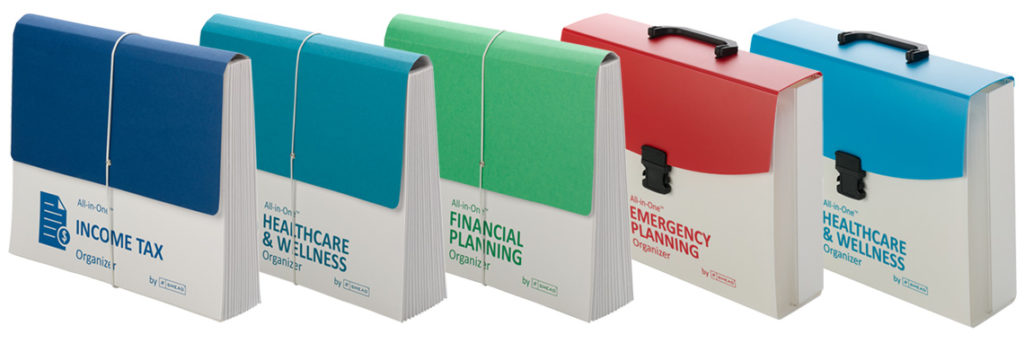
All-in-One™ Emergency Kit
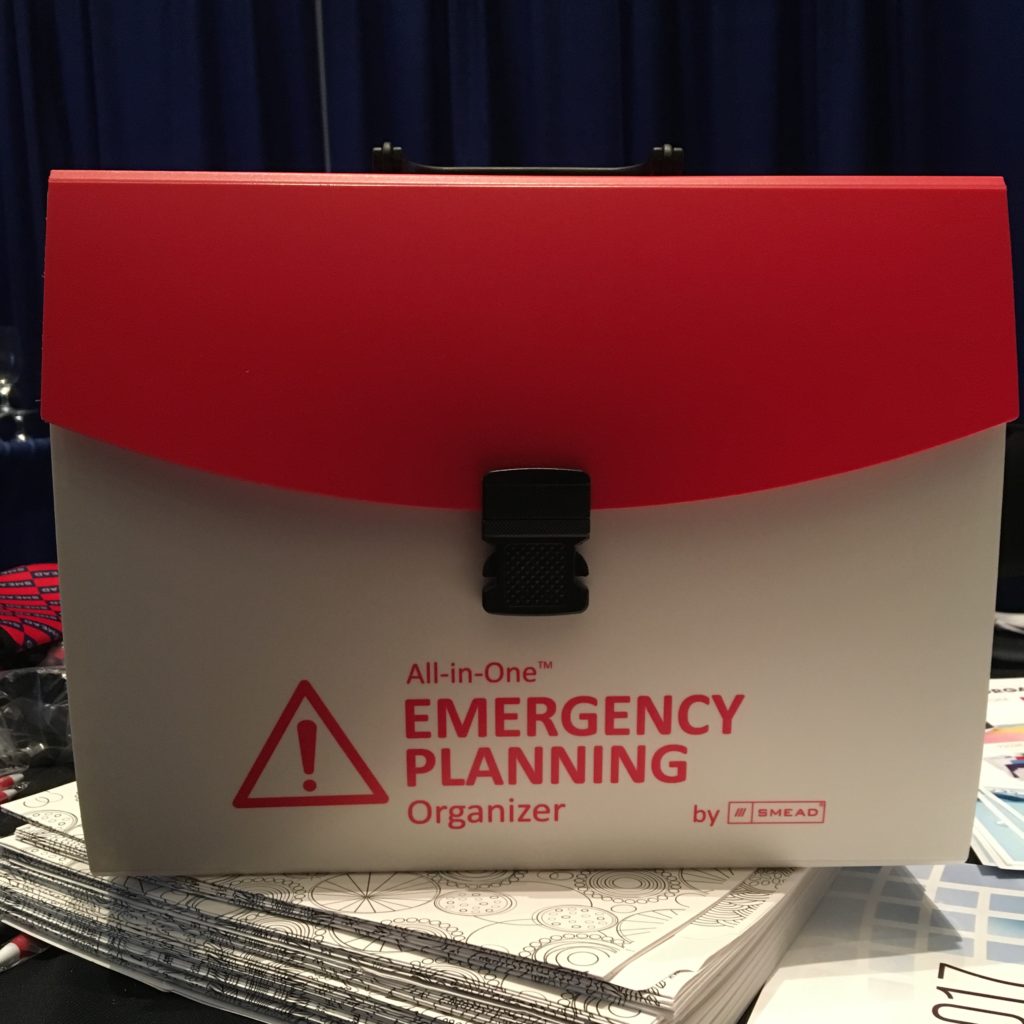
This snappy red-and-white (First Aid-themed) durable poly organizer has 12 interior pockets and includes Viewables® labels. The kit has a plastic handle for portability and a latch closure for security.
All-in-One™ Healthcare & Wellness Organizer
For healthcare, there are two versions of the kit:
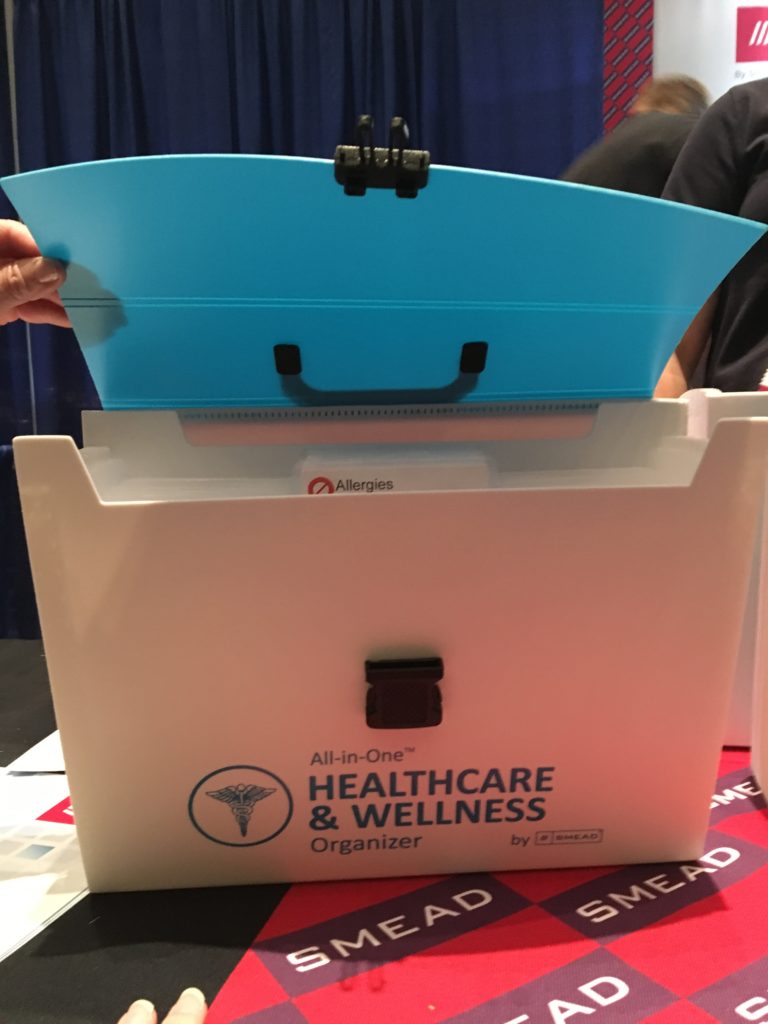
The boxier durable poly organizer is identical in design to the Emergency Organizer Kit, but with a soothing blue and white theme, and has a plastic handle and latch closure, 12 interior accordion-style pockets, and Viewables® labels.
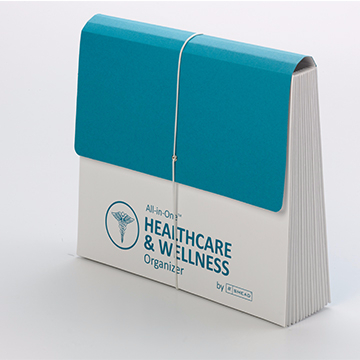
For those who prefer paper to poly, there’s a durable paper Healthcare & Wellness accordion version, with an over-the-top paper flap and elastic band closure. There are 12 expandable pockets with one large pocket in back, and it also includes Viewables® labels.
All-in-One™ Financial Planning Organizer
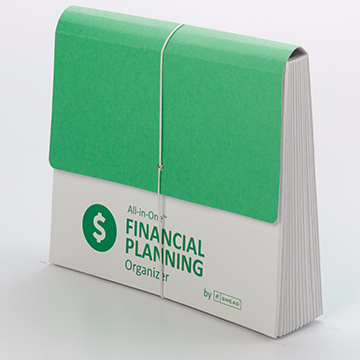
All-in-One™ Income Tax Organizer
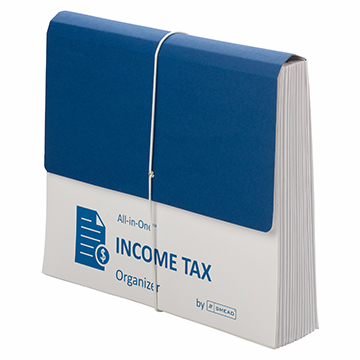
Both the green and white Financial Planning Organizer and the navy blue and white Income Tax Organizer come in the durable paper version, with an over-the-top flap and elastic band closure, 12 expandable pockets with one large pocket in back, and Viewables® labels.
The Financial and Income Tax organizers, as well as the paper Healthcare & Wellness Organizer, contain 10% recycled content and 10% post-consumer material.
The All-in-ONe™ Income Tax Organizer is currently available at Amazon and office supply stores, and runs about $18. The remainder of the All-in-One™ Organizer Kits are branded COMING SOON, so pricing information is not yet available.
Create a DIY Kit With the Smead Poly File Box
Sometimes, you have a clear idea of what you want to create, but you don’t want to have to go in search of putting all the pieces together. I wasn’t surprised to find that myOrganized.life has an option for that, too. You could start with the Smead Poly File Box (suitable for desktop or in-drawer use) and add your own hanging folders and tabbed interior folders, in whatever color schemes you prefer, using whatever labels fit your needs.
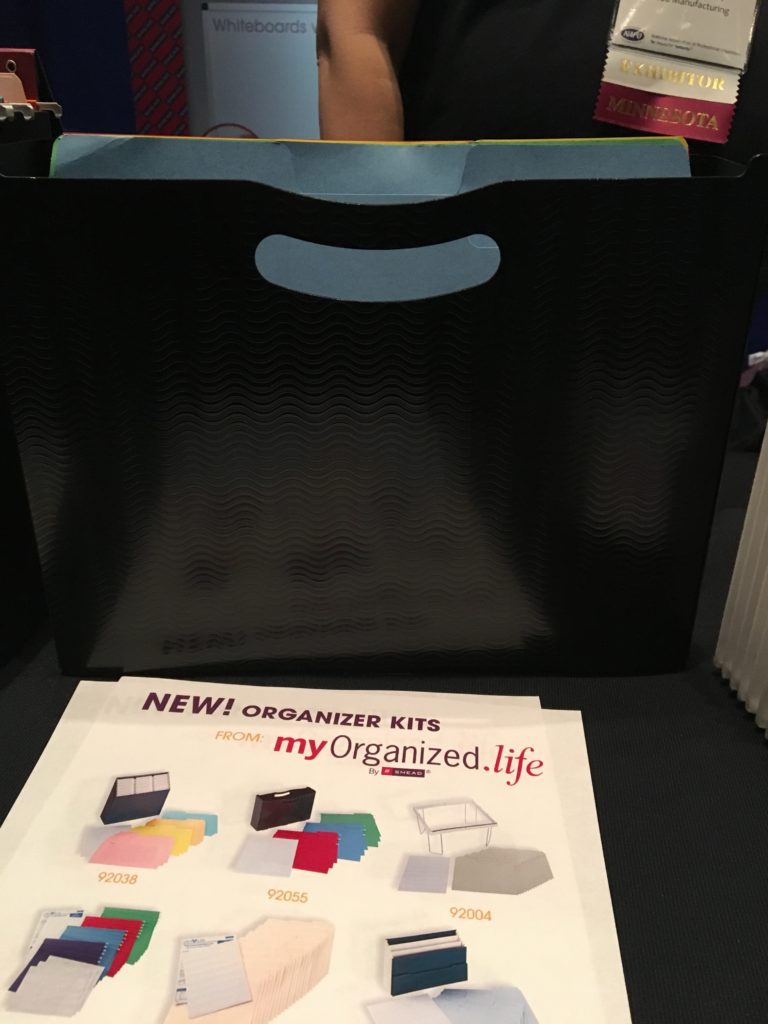
It’s a sturdy poly file box and holds up to 3″ of files, directories, or similar materials, and can be used with hanging files and interior folders, or just folders, depending on your needs and preferences. The Smead Poly File Box is harder to find in brick-and-mortar stores than online, and runs from $8.95-$10.55.
Conversely, you could opt for the Poly File Box with SuperTab® Folder and Viewables® Labels Kit.
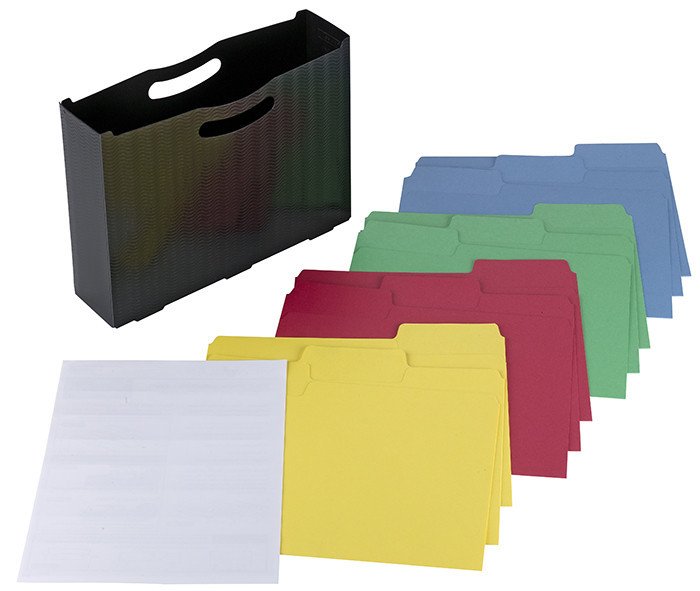
The kit comes with one black poly file box, 12 colored one-third cut SuperTab® file folders (three each of yellow, red, green, and blue) and 16 Viewables® labels. The SuperTab® folders have a 90% larger labeling area than standard folders, so you can use larger text or more lines of description. The file box is lidless, so you’ll want to make sure that if you need it to be portable, you’re holding it securely and upright. The Poly File Box with SuperTab® Folder kit runs upwards from $11.95.
And that’s the straight talk on Smead’s organizer kits. No caboodle!
Paper Doll’s NAPO 2017 Recap: Samsill Upgrades Pop N’ Store & Pleases Paper Mommy
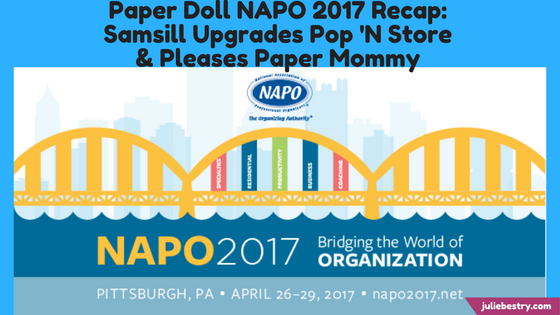
Every year at the NAPO conference, we look forward to seeing new products and hearing about upgrades to ones we’ve seen before. This was definitely the case with Paper Doll‘s visit to the Samsill booth at NAPO 2017, and it was a delight to know that Samsill paid attention to customer and professional organizer feedback for making their products even better.
In last year’s Paper Doll‘s NAPO2016 Recap: Samsill’s Duo & Trio & Pop…Oh, My!, we took the time to get to know Samsill, previously famous mainly for its binders, and got to explore its new offerings, particularly the Pop N’ Store line of attractive storage boxes, flat-packed but ready to POP up into functional form in five seconds.
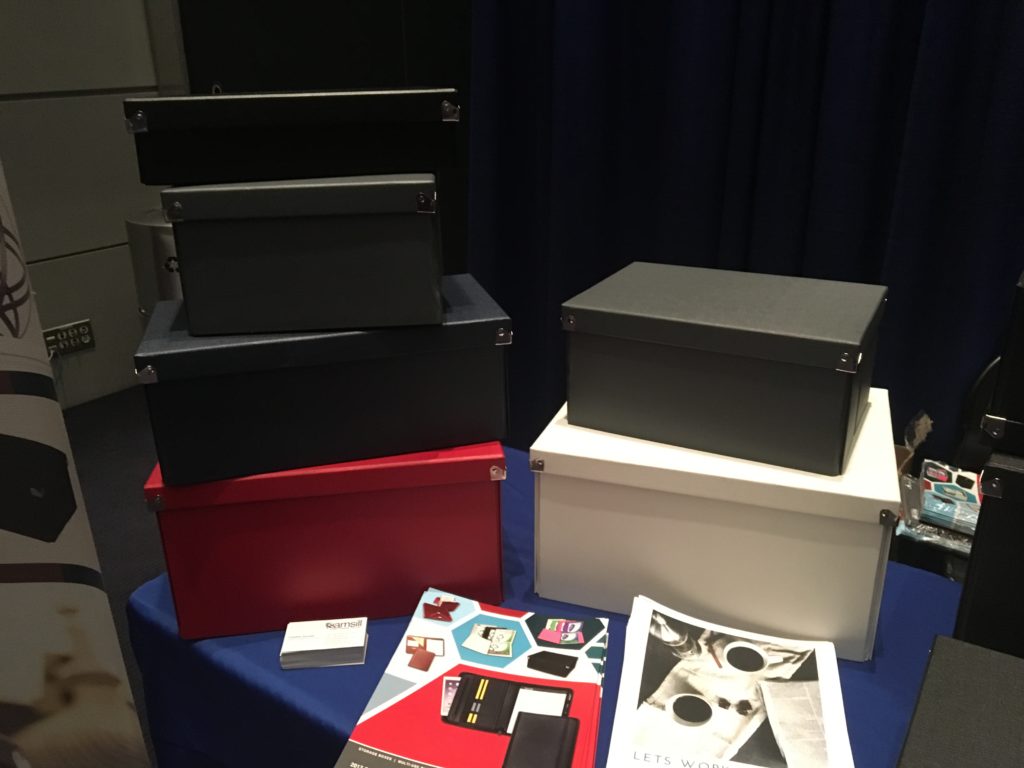
The Pop N’ Store boxes introduced last year are made of heavy-duty chipboard and are covered with Lotus Seed™ textured paper. The corners of the original Pop N’ Stores are metal-reinforced for added durability and charming aesthetics, while the box bottoms are covered in a scratch-resistant fabric designed to protect delicate surfaces, like fancy-schmancy tabletops and shelves. The boxes are made of 100% recycled material and 70% post-consumer material.
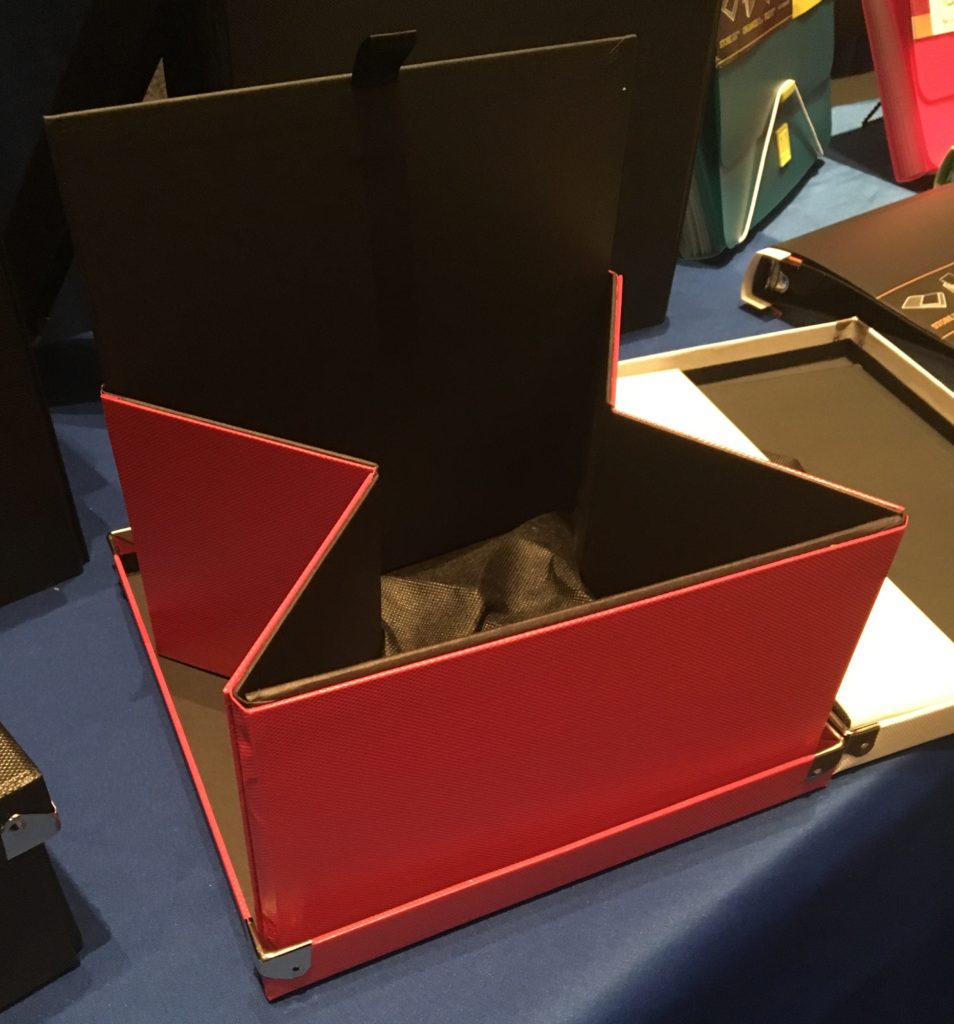
Samsill really understands the advantage of flat-packed, collapsible, stackable storage. College kids need an easy way to move into and out of their dorm rooms and apartments; office-dwellers enjoy the ability to mix-and-match supplies as needed without having excess empty boxes on display; and professional organizers love being able to bring solutions to clients without giving up breathing room in our vehicles.
Originally, the lidded, decorative storage boxes came in six colors (black, navy, red, brown, grey and white) and five sizes with the following (internal) dimensions:
- Document Box (12″ x 8.5″ x 3″) for $11.99
- Essential Box (14.625″ x 7.5″ x 5.34″) for $12.99
- Medium Document Box (12″ x 8.625″ x 5.8″) for $14.99
- Medium Square Box (9.75″ x 9.75″ x 5.75″) for $11.99
- Mega Box (14.625″ x 11.875″ x 7.34″) for $16.99 all at Amazon
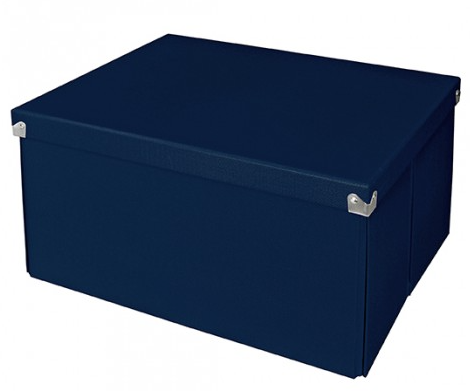
But it was this year’s newcomer to the Pop N’ Store collection that really caught my eye. First, however, some personal background. Longtime readers of the blog know that the inspiration for all things organizational is Paper Mommy of Paper Mommy Knows Best fame. Unfortunately, last December, Paper Mommy was viciously attacked by a rogue comforter while stripping her bed and had a bad fall, directly into a wall, fracturing her C2 vertebra and her wrist.

Note, even with a severely fractured wrist, Paper Mommy maintained perfectly manicured fingernails. However, it must be noted, in the final score, it was Wall: 1, Paper Mommy: 0.

It’s a testament to how loveable she is that I flew to Paper Mommy HQ in Buffalo in mid-January to help her tackle all of her financial and medical paperwork. Normally, Paper Mommy‘s files are kept in her kitchen office drawer, but accessing them while one-handed and wearing a neck brace was proving to be problematic. However affable she is in general (and that’s a lot), as a client, she was a bit persnickety, and rejected all suggestions for potential desktop file boxes. However, I believe that if we’d known about Samsill’s newest line extension, she’s have acquiesced happily!
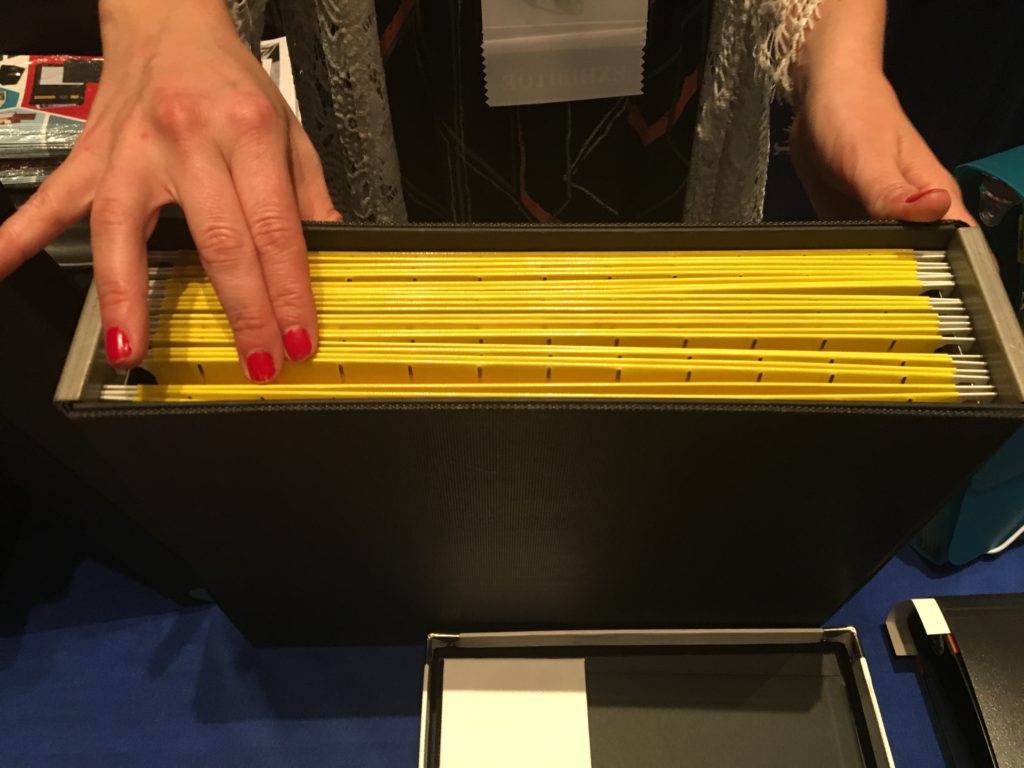
The organizing community told Samsill, “Hey, we love the Pop N’ Store boxes, but why don’t you have a filing box? Something flat-packed and pop-up-able, but with a hanging file rail?” So Samsill made one. And, “Oh, could it have a lid, too?” And Samsill said, “Make it so!”
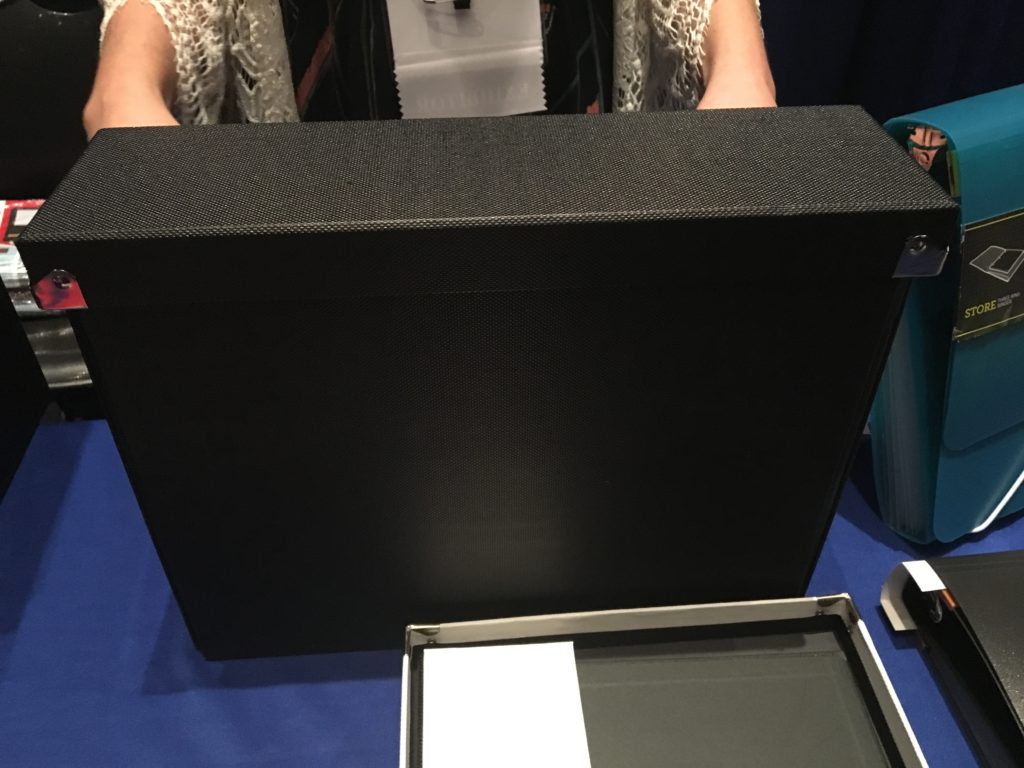
Along with the file box, there’s also a new cube-style box for fitting perfectly with those Ikea-esque cube shelves, and a new smaller box for corralling small doodads.
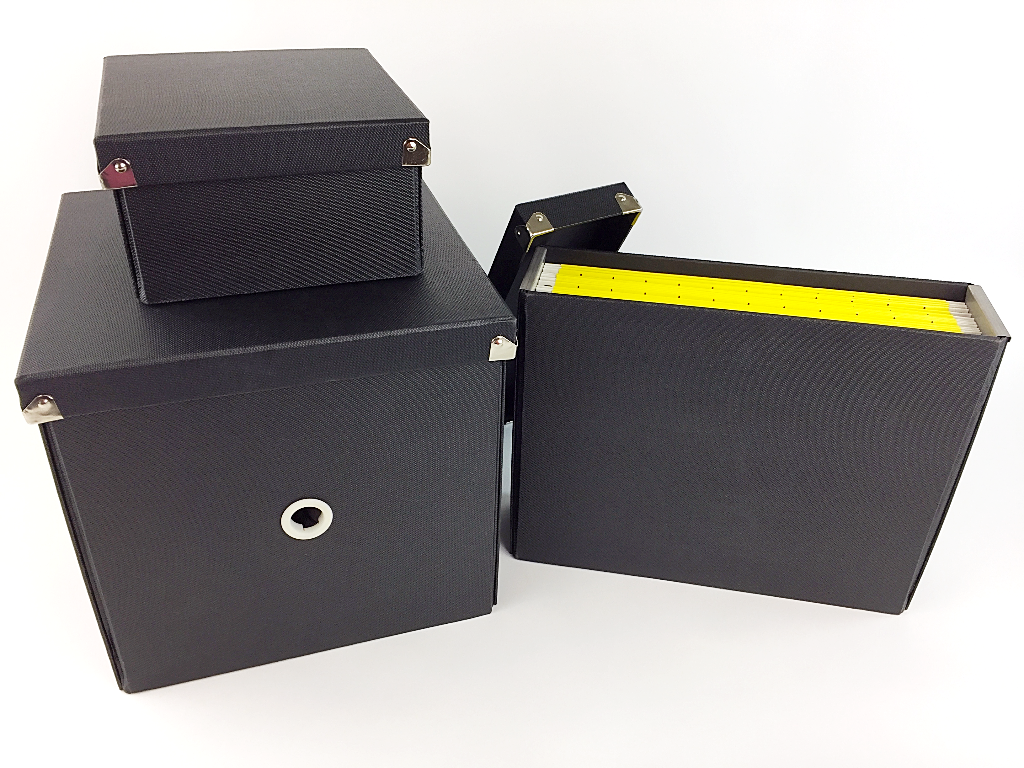
These new boxes have been designed with the same heavy-duty chipboard and Lotus Seed™ textured paper, so they’re as sturdy and elegant as the original Pop N’ Stores. For next year, I hope Samsill continues to upgrade this series by adding bright, cheery colors. (Black, navy, red, brown, grey and white are fine for oh-so-serious workplaces, but for the rest of us, let’s hope Samsill brings their usual penchant for brightness to this line, too!)
The products are so new, the measurements and pricing have not yet been announced. Follow Samsill’s accounts on Facebook and Twitter to be updated when they become available.
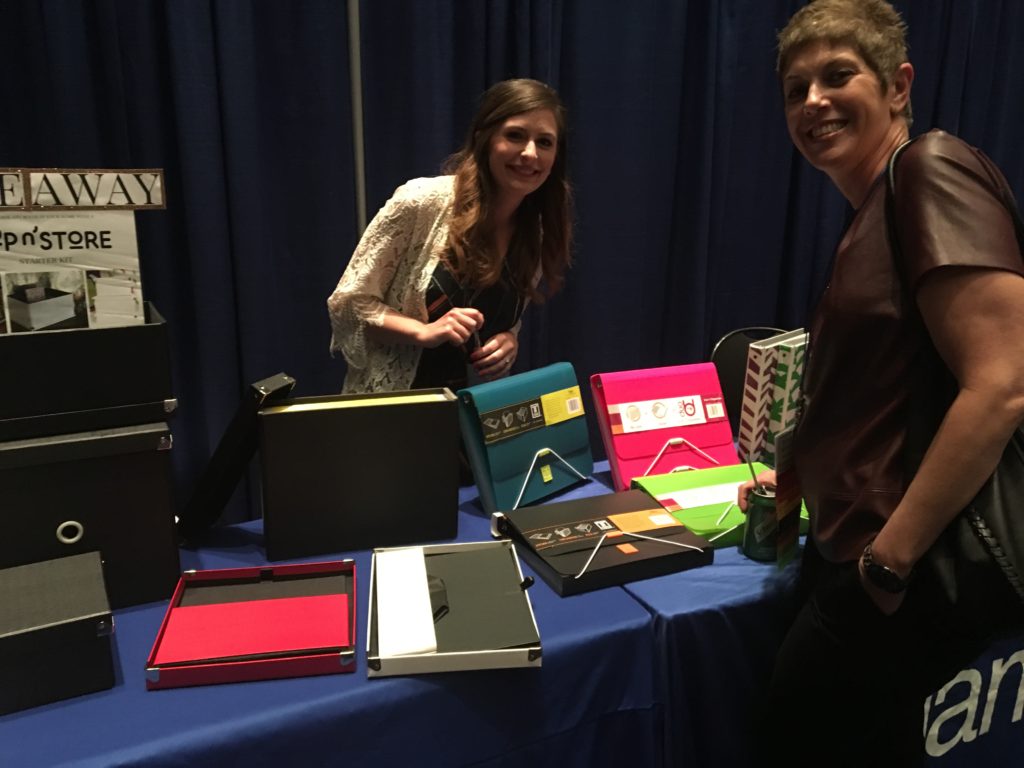
Above, I caught Samsill’s Digital Marketing Associate, Christine Hampel, chatting with New York City professional organizer Leslie Josel. In addition to being Paper Doll‘s fellow Cornell University alum (Go Big Red!), author/organizer/inventor Josel is a stellar student organizer, head honcho of Order Out of Chaos, and the mastermind behind the award-winning Academic Planner: A Tool for Time Management® (deserving of a blog post in its own right).
The Samsill DUO 2-in-1 Organizer combines a seven-pocket expanding accordion file with a 1″ three-ring binder. The file portion holds up to 225 sheets of paper, and the accordion-style expanding section includes blank write-on index tabs so you can customize your labels. The DUO weighs 14.6 ounces and measures 9.8″ x 1.5″ x 11.8″.

I’ve previously described the DUO as a grown-up Trapper Keeper, perfect for storing tax prep documents or financial information (budget, bills, coupons, and shopping lists), family medical files (with categories for tests, prescriptions, and dietary rules), or household plans (with sections for decorating, monthly upkeep, garden plans, etc).
The durable and water-resistant DUO is made of PVC-free, acid-free, archival-safe, environmentally flexible polypropylene and comes in hot pink, turquoise, green, burgundy, orchid, black, light blue, and coral.
The DUO (seen below, right, in hot pink and green) was originally designed with dual elastic clasp and cord closure to provide access to each portion (pockets or binder) individually while maintaining a secure closure to either or both sections.
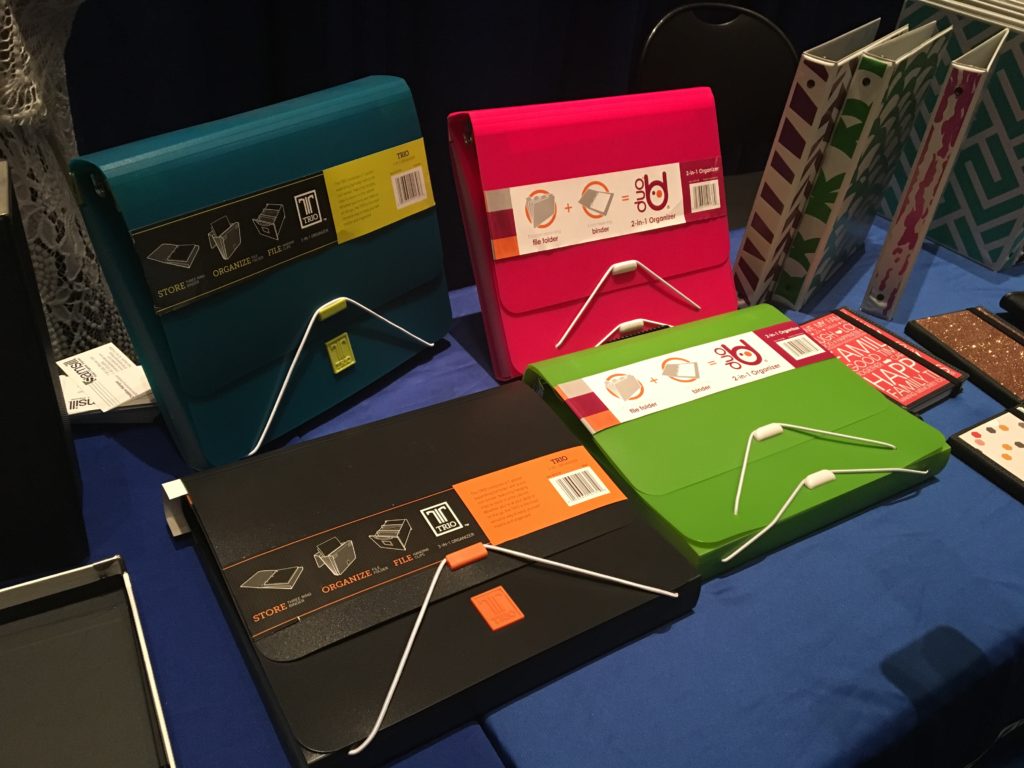
Leslie Josel’s work with students led her to provide feedback to Samsill regarding how to improve the already-nifty DUO and TRIO portfolios we’ve previously covered. For example, note the original DUO on pink on the left, with the dual elastic. Leslie found that her students were having trouble manipulating the two elastic bands and keeping the DUO open, so Samsill is modifying the design to include a Velcro closure and other rumored advances.
The TRIO, Samsill’s 3-in-1 Organizer, which also got so much attention last year (seen in black and turquoise, above, left), has all the same features as the Duo.

However, the TRIO also has retractable hangers, turning the entire TRIO into a combination hanging file, binder, and interior folder set. Store it in a file cabinet, filing drawer in your desk or desktop file box. Thanks to the hangers, even though the Trio is poly, you never need to worry it’ll slide to the bottom of the drawer.
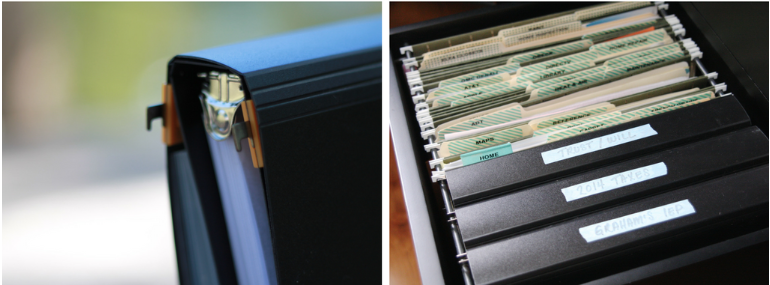
The word is that there are also design modifications on the horizon for Samsill’s TRIO, but shhhhhhh. Spoilers, Sweetie.

Watch Samsill’s blog for updates, such as the post for their new Padfolios, and find Samsill products on Amazon.
Paper Doll’s NAPO 2017 Recap: New Twists on Time Timer
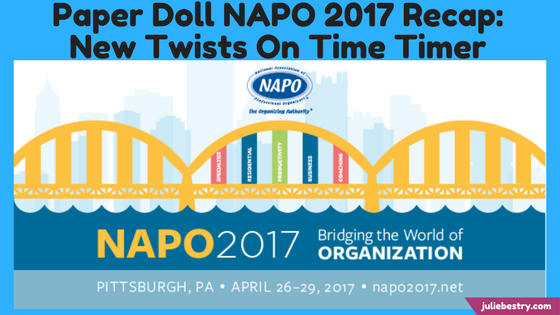
The concept of time management (as opposed to its practice) is simple: identify your priorities, spell out the tasks to complete, and focus on them for a period of time. When appropriate, transition to other tasks. Done!
But what if “time” is a fuzzy concept for you? Well, you wouldn’t be the first. Not long after returning from NAPO 2017, I took one of Tara McGillicuddy’s superb ADDClasses.com webinars, ADHD and Punctuality: Even You Can Learn to Be On Time with ADHD Coach Lynne Edris. Although I have an innate sense of the passage of time, possibly from my prior career working in television (where time is, literally, money), the issue of conceptualizing time in order to work productively with it is something that plagues many who seek help with organizing and productivity.
During the webinar, Edris talked about how some of the contributing characteristics of ADHD, including distractibility, impulsiveness, and hyper focus, impact time blindness, as defined by Dr. Russell Barkley.
WHAT DOES TIME LOOK LIKE? WHAT DOES TIME FEEL LIKE?
When you have a strong sense of time, you are aware of what time it is now, how much time you have left (to perform a task, or before you have to change gears and transition to a new task or location), and generally how quickly time appears to be passing. When your sense of time is wonky, your productivity can feel cursed.
I once had a client, a successful engineer, who overestimated how much time some tasks would take (causing him to procrastinate and avoid the labor) and underestimate how long others usually lasted (leading to double-booking as meetings ran long). As a test, I once encouraged him to work for fifteen minutes on a task he’d been avoiding, while I observed him. After eight minutes, he looked up, exasperated, certain that I had lost track of time and that far more than fifteen minutes had elapsed. Nope. Again at twelve minutes, he was sure either I or my timer was off. In terms of engineering, this client was a genius, but he had the conceptual sense of time of a pre-schooler. And he’s not alone.
Of course, none of these factors are unique to those with ADHD. I think we have all experienced time dilation such that ten minutes in the final act of our favorite television show can speed along (darn you, Shonda Rhimes!) while ten minutes while waiting in the “little room” at the doctor’s office, relentlessly bored and denied the ability to people-watch, drags by.
Learning how time works — mapping the representational to the reality — can also be problematic. For example, we know that digital time is harder for children to comprehend than analog time — and this can be the case for some adults, too. Take this anecdote about the author Douglas Adams:
In the early days of personal computers, he said, people got very excited that their spreadsheet programs could finally create pie charts. This was considered a revolutionary advance, because as everyone knows, a pie chart visually represents a part-whole relationship in a way that is immediately obvious—a way that, to be more specific, mere columns of numbers did not. Well, the hands of an analog timepiece form wedges that look very much like a pie chart, and like a pie chart, they represent a sort of part-whole relationship in a way that requires a bare minimum of mental effort to comprehend. Not so digital timepieces, which for all their precision say nothing about the relationship of one time of day to another.
It’s just harder to conceptualize — visualize — the passing of time with digital clocks. They’re merely numbers separated by colons. But the analog clock provides a clear visual distinction between moments — and this is the central advantage of one of the most popular time management tools the organizing and productivity industry has ever seen: Time Timer®.
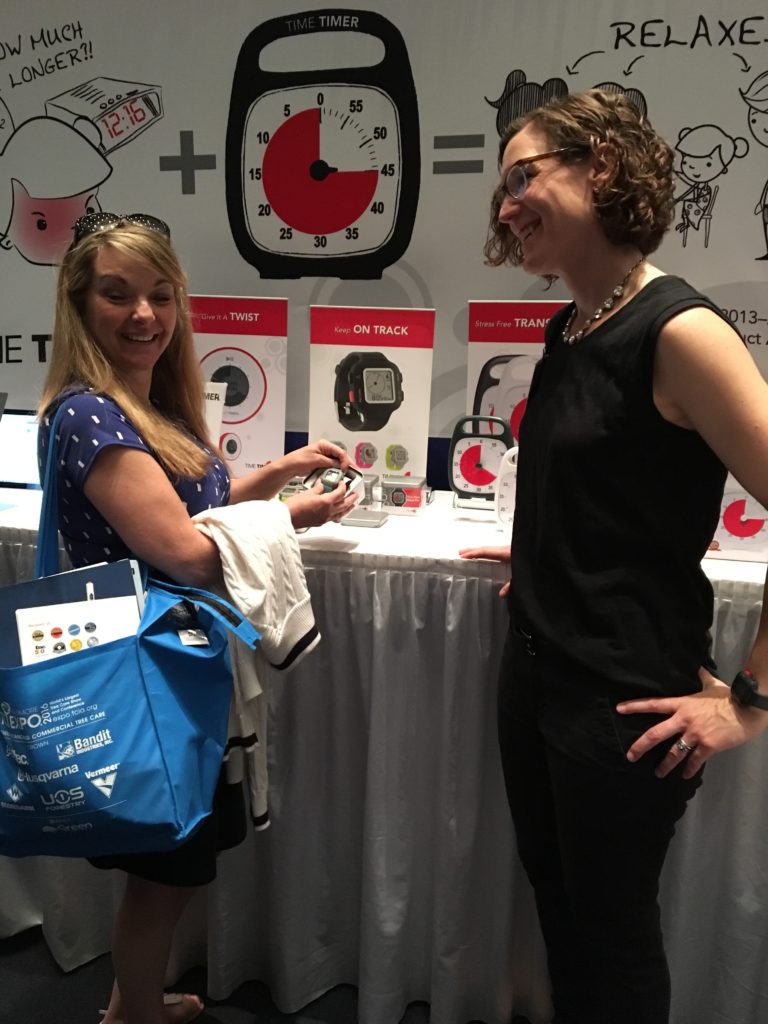
The original Time Timers were plastic, battery-operated, analog countdown clocks. Rather than a minute hand and second hand, Time Timers had red, circular cellophane-like discs that diminished in size (from a maximum of 360° coverage for an hour) until the time was up, and then the red portion disappeared (hiding behind the clock display) and a buzzer went off. Kids (and adults) using the Time Timer were able to get a sense of the “feel” of how time passed.
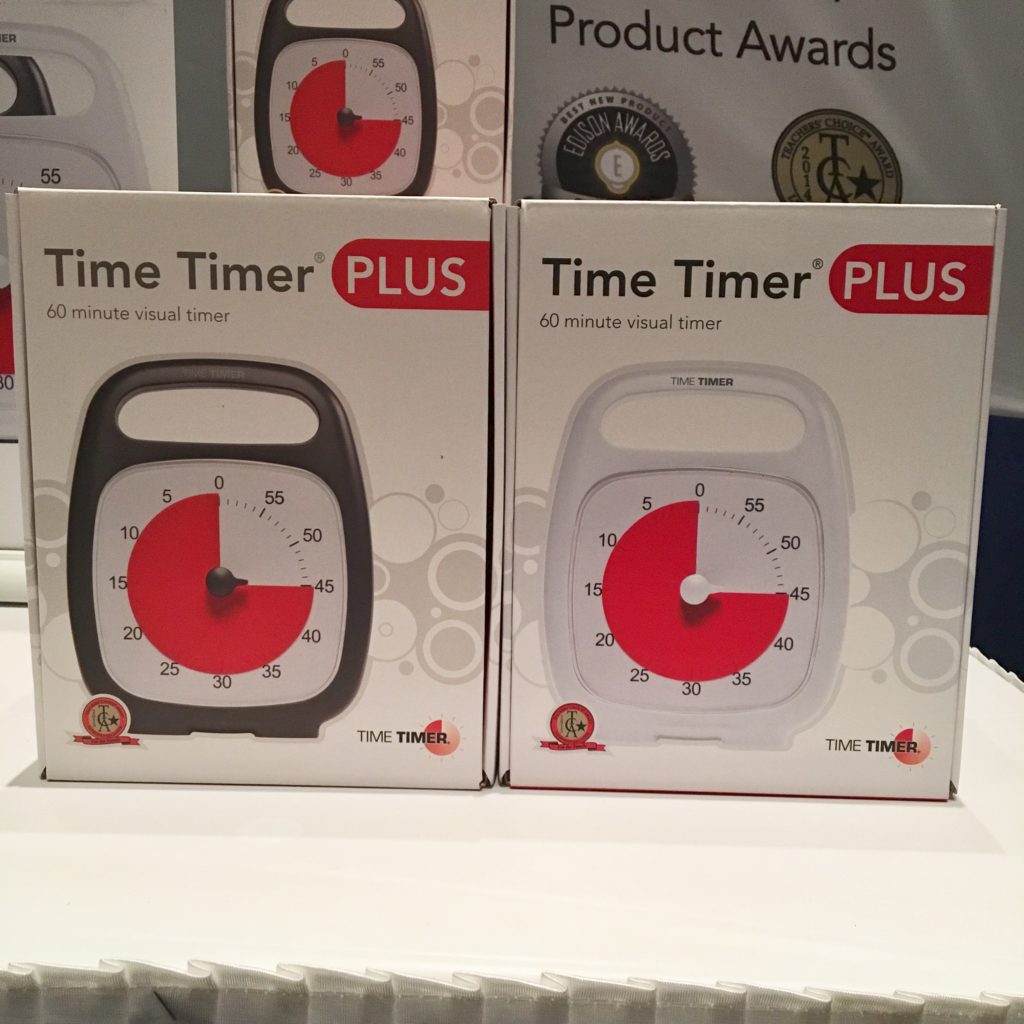
Paper Doll has covered Time Timer many times, most recently in our detailed coverage of NAPO 2016’s Organizers’ Choice Award Winners. But our friends at Time Timer know that time marches on, and so do they. Let’s look at some new developments on the time front!
NEW DURATIONS — THE LONG AND THE SHORT OF IT
Historically, all of the Time Timers (the Plus with the quick-grab handle, the 3″, 8″, and 12″ handle-free versions, and the adorable and brightly colored little Mods) have all had one thing in common: they measured durations of up to 60 minutes. For children, and for anyone who has a general difficulty with visualizing time flowing, this makes sense — the Time Timer emulates how time elapses on a clock face.
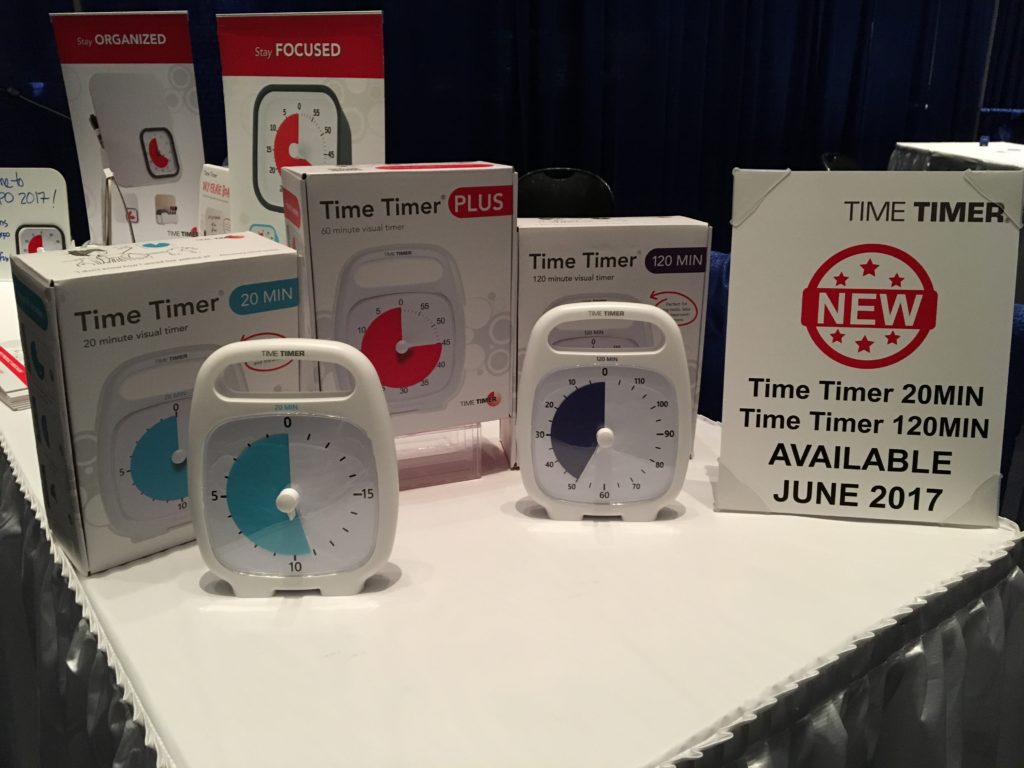
The two new versions of the Time Timer look like the traditional (white) Plus with the quick-grab handle, but have two new distinctive features. First, the new versions come in two different durations: 20 minutes and 120 minutes. Second, for the first time, instead of red, the time-elapsed disc is in new colors, robin’s egg blue for the 20-minute timer and purple for the two-hour version.
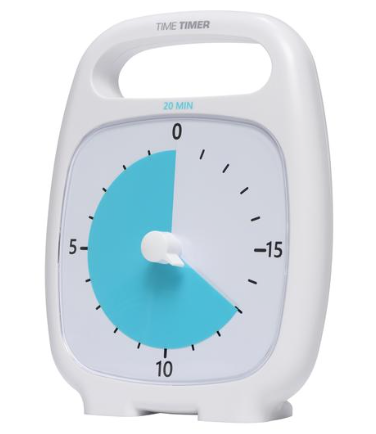
The 20-minute Time Timer is designed to offer a greater visual impact for shorter tasks like homework blocks and practicing musical instruments, as well as keeping on-task for workplace meeting agenda items. Because it doesn’t emulate the hour-long clock face, it’s definitely better suited for those who understand how time flows, but merely need visual reminders of its passage. I think it’s an attractive addition to the line, but feel Time Timer missed a chance to capitalize on the productivity industry’s love for the Pomodoro Technique and should have created a 25-minute timer.
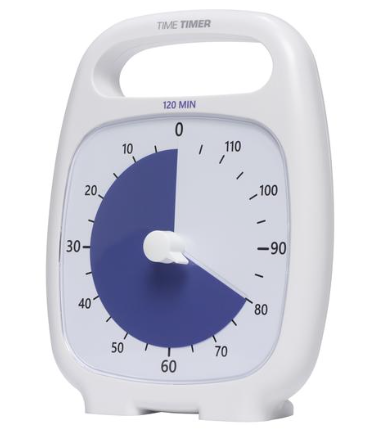
I can see the 120-minute version of the Time Timer working well for high school and college students taking timed practice tests and for keeping both adults and kids on-task for larger projects.
Both of the new versions run $38.95, use one AA battery, and have a volume control for the “done” tone. Both will be available as of June 2017.
THE BIG NEW TWIST
You know you’re at a conference for professional organizers when you hear people squeal in delight from across the room — over a new timer shape! The hubbub of the expo this year was definitely, “Have you seen the Twist?” Chubby Checker would have been impressed!
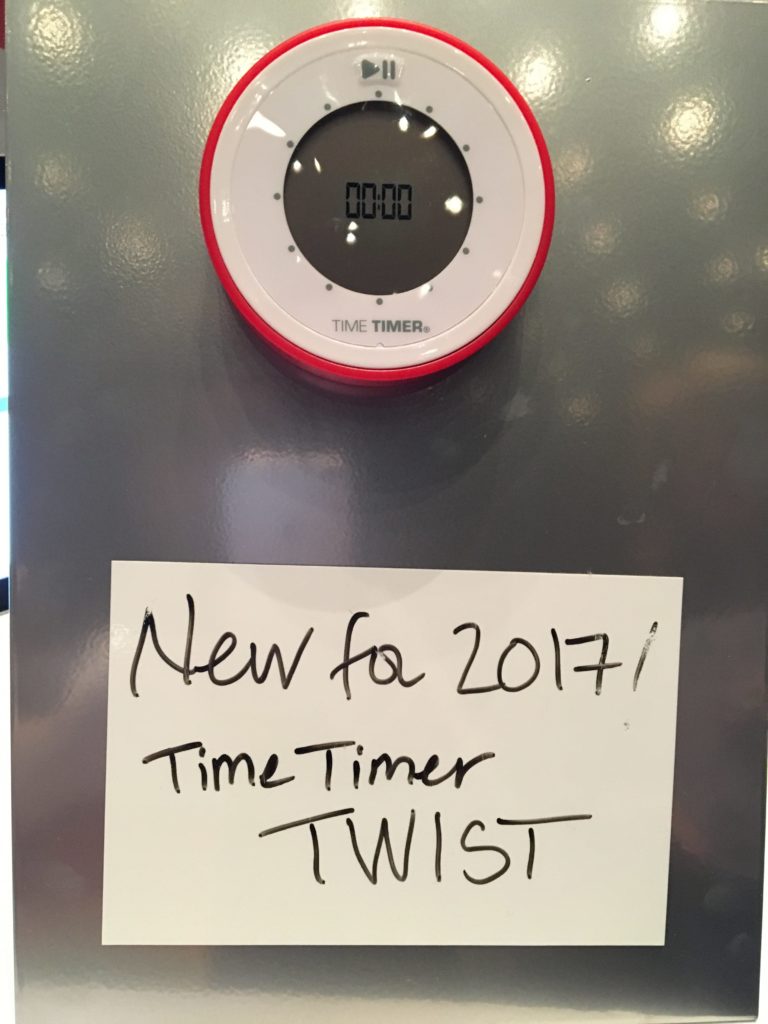
The first thing you notice is that this new Time Timer is round! As all other versions of the Time Timers could stand on their own, you might wonder how to ensure that you can see the face. Magnets, baby! The external ring is in the classic Time Timer red, while the ring around the face is white, with a grey central section for the time display.
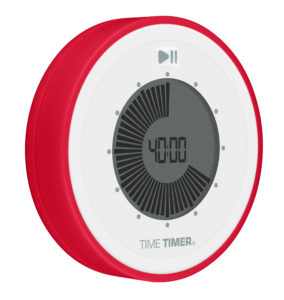
Set this unique timer for up to 90-minute durations by turning the outer ring. Verify the timer digitally, but watch it count down in an analog format — silently, of course, like all other Time Timers. Then stick it on your fridge or filing cabinet for an elegant way to visualize the passage of time.
THERE’S AN APP FOR THAT
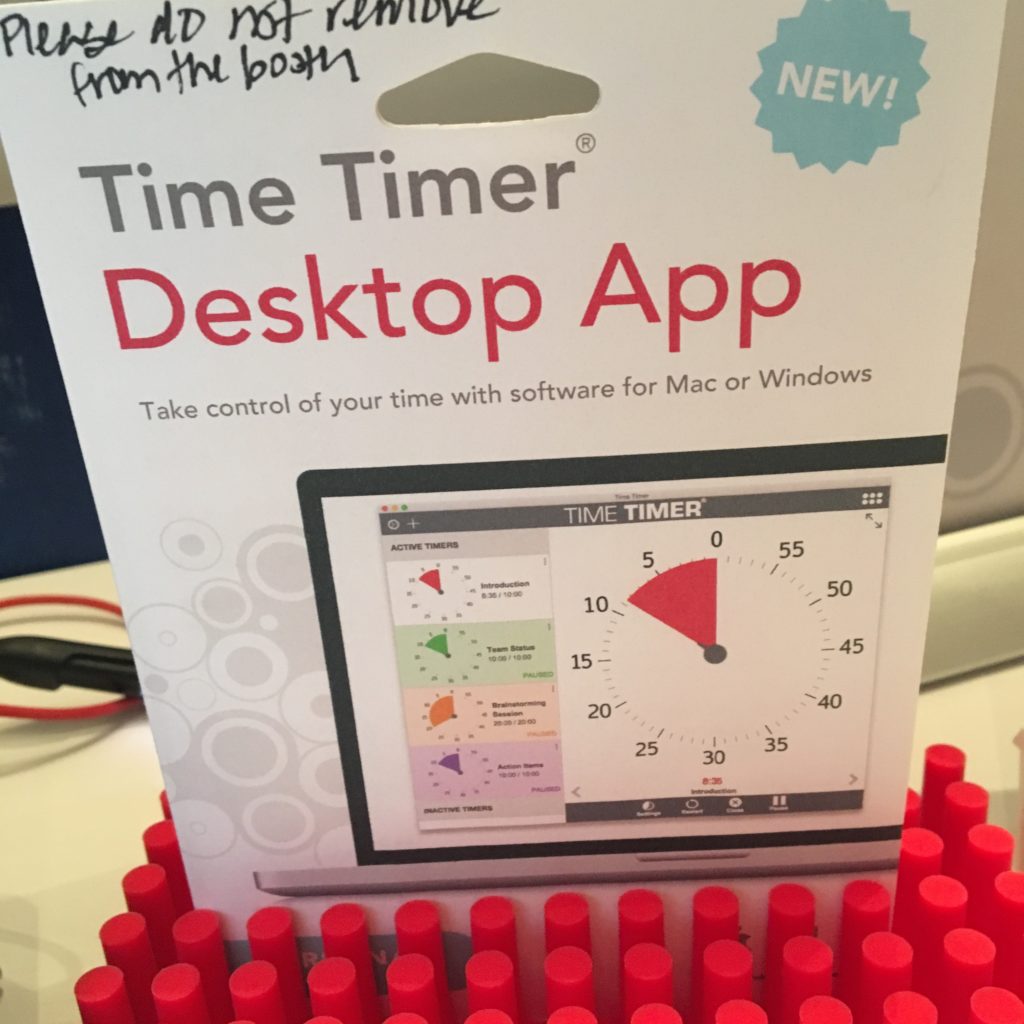
Fans of Time Timers were delighted a few years ago when the iPhone and Android apps were launched, and the multi-color Time Timer iPad app wasn’t far behind. With all three, you can customize your countdown timers, save and name them for re-use, change colors, create alert options, and more. What was missing was a desktop app — until now.
The Time Timer Desktop App comes in eight languages: English, Danish, Dutch, French, German, Japanese, Portuguese, and Spanish. It’s compatible with Mac and Windows, and sells for $19.95.
OH, WILL YOU LOOK AT THE TIME?!
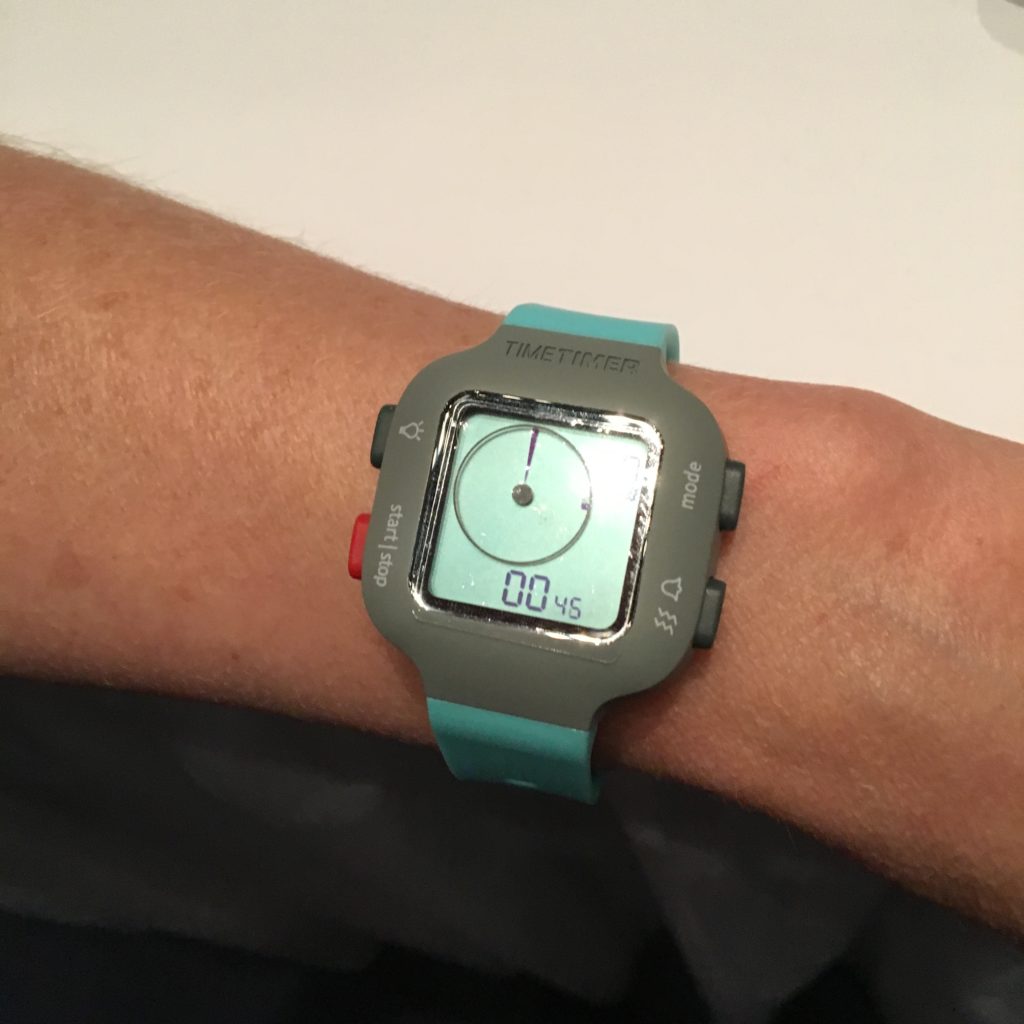
In addition to a wide variety of timers, apps, and watches loved by most organizers, there’s a special place in Paper Doll‘s heart for one particular Time Time accessory: the Time Timer Dry Erase Board.
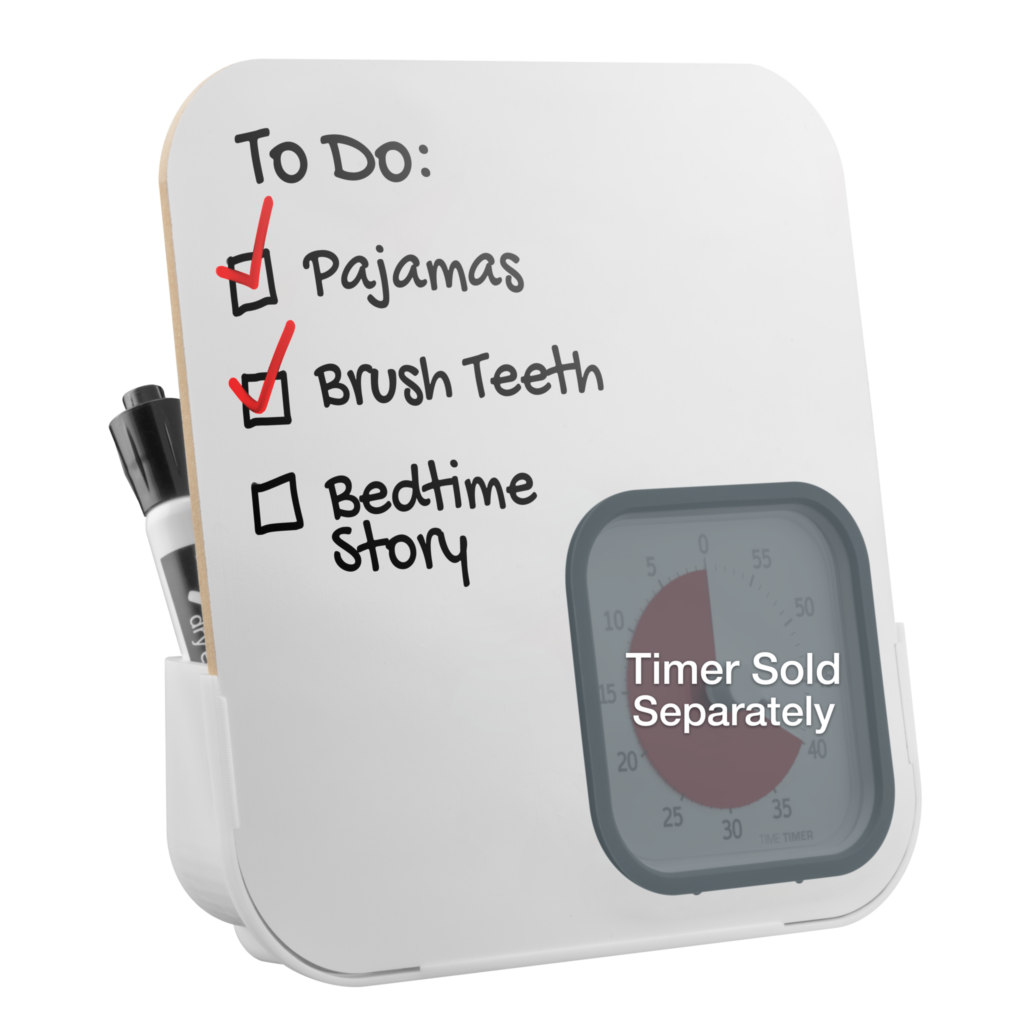
This small, desktop-suitable, dry-erase board has a cut-out space perfect for my favorite Time Timer, the Mod (with the Berry cover). Heather Rogers, Time Timer’s VP of Marketing and Operations, illustrates the advantages of the board, which runs $18.95, below.
(Now they just need a magnetic Twist/dry-erase combo!)
THE ADVANTAGES OF VISUALIZING TIME
Even people who are adept at managing time, in general, can be led astray due to excitement or adrenaline. At my NAPO-Georgia meetings, a modern Time Timer is on display to ensure that speakers maintain focus and keep to the schedule. At a recent committee meeting, we used a classic Time Timer to ensure nobody had to be the bad guy and cut off overenthusiastic participants. Time Timer’s website notes a variety of uses of their products in different realms, including:
At Work
- Maximize efficiency with LEAN manufacturing principles—time is money!
- Keep meetings on track at a glance, giving everyone equal time to participate.
- Creatives: generate ideas more quickly through timed brainstorming.
- Healthcare: keep schedules moving and effectively manage time spent with patients and clients.
- Sales: deliver succinct, impressive presentations without the “mental math” of how much time remains.
At School
- Teach the concept of time and learn to visualize time as a measurement: What does “5 minutes” really mean?
- Manage transitions in (and out of) the classroom.
- Transition “ownership,” allowing educators to be children’s ally, not the “enforcer” of the classroom schedule.
- Keep students calm, focused, and aware of time during practice and while conducting timed standardized tests to satisfy state standards.
At Home
- Ease and manage daily routines: morning, dinner, cleanup, bath & bedtime.
- Monitor turns and time for homework, computer use, instrument practice and play time.
- Manage time-outs: help children calm down and watch frustration fade as the red disk vanishes.
- Encourage punctuality: when the red disk disappears, we’ll go!
- Organize: keep track of valuable time and break large, overwhelming projects into small, manageable 10-minute activities.
Do you use a Time Timer? Is there a version you’d like them to make? Share in the comments.
Paper Doll’s NAPO 2017 Recap: Schooling the Organizers

What do professional organizers do at a conference, you may wonder. Do we rearrange the hotel room furniture, tell the housekeeping staff how to declutter their carts, and roam the halls looking for dysfunction we can set right? (Maybe, no, and sorry, but I’ve been sworn to secrecy.)
Each year, Paper Doll takes time out to share the delights of the National Association of Professional Organizers (NAPO) annual conference and expo. Sure, the focus here on the blog is generally on the goodies at the expo — the products and services that delight and surprise us (so I can delight and surprise you) — but I always like to take time out to share what happens with the rest of the conference.
Today, before we settle in for multiple posts on the wares displayed at NAPO2017 in Pittsburgh, I’d love to tell you about what we learned.
EDUCATIONAL TRACKS
Some professional organizers are Certified Professional Organizers or aspire to do so, and our conference is one of the many ways we earn some of our Continuing Education Units (CEUs). But all of the professional organizers attending our conference, no matter how little or great their experience, travel far and wide for the exemplary educational opportunities available.
This year’s NAPO conference had six educational tracks:
- Business Operations & Growth — These sessions focused on topics like getting media attention, hiring teams to grow your business, speaking professionally, leadership concepts, and some behind-the-curtain discussions about the profession.
- Client Interaction — I always tell clients that the difference between cleaners and professional organizers is that cleaners focus on the stuff, and professional organizers focus on the person who owns the stuff. In this track, we covered working with clients in mourning, non-verbal communication skills, eliminating “brain clutter,” building rapport via listening skills, and understanding our clients with ADHD.
- Niches — There are more than 40 sub-specialties within the professional organizing field. During NAPO2017, educational sessions covered ADHD (including improving communication when one spouse has ADHD and empowering those with ADHD), working with estates, organizing academic professionals, and offering virtual organizing services.
- Residential Organizing — From organizing overwhelmed families and understanding our clients’ unspoken concerns, to smart space design and appraising household possessions, attendees had multiple options for investigating new niches for their residential-oriented organizing services.
- Technology in Organizing — Technology sessions provided knowledge about eliminating email overwhelm, technology tools for productivity, time management and technology strategies for the home, and using Evernote to capture and organize clients’ memories.
- Workplace Productivity — From business consulting and corporate productivity and organizing sessions to How to Prioritize When Everything is Important to an introduction to QuickBooks, this track improved attendees’ ability to expand their expertise in productivity issues for themselves and their clients.
PAPER DOLL GETS SCHOOLED
I like to mix things up and take offerings from all of the tracks. Some years, I lean more toward one theme, like technology or productivity, but this year, different mini-themes began to emerge. For example, on the first full day of the conference, I noticed that I was focusing on death. It may sound maudlin, but it was actually a very enlightening day.
First, I attended Empowering the Grieving Client to Organize with Joy, presented by Dorothy Clear, CPO®. In the residential side of my organizing practice, I’m called in to help clients who have been stuck, either unable to process grief or find themselves dealing with the detritus of the fugue state in the aftermath of a loss. Western society tends to think of mourning and grief as finite — measured in eight days or six months or a year — by which time people are expected to be “whole” again, but anyone who has suffered grief knows that it comes in waves. Thus, grief is less like having the flu and more like having a chronic illness — there are good days and bad ones, and a small thing can cause the day to turn on a time.
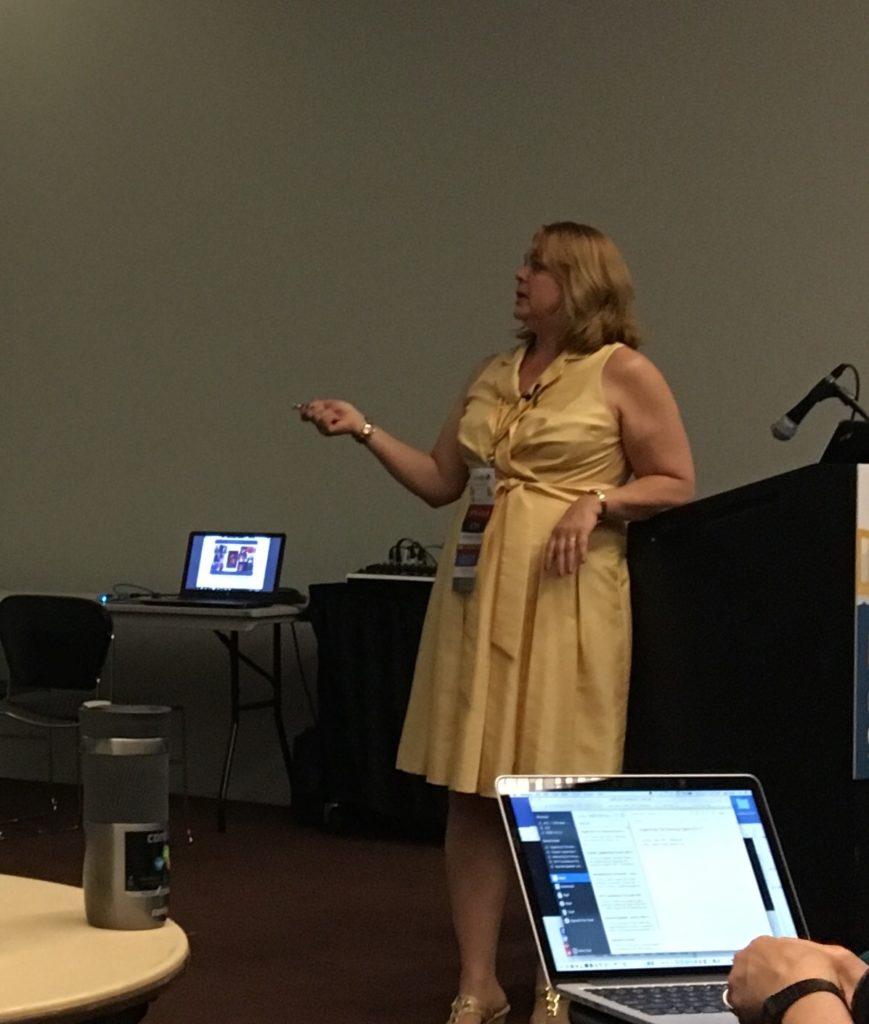
In Dorothy’s excellent session, we learned how to recognize the physical manifestations of grief, and delved into the differing types of grief, including anticipatory grief, unanticipated grief, ambiguous grief, and complicated grief. Dorothy also taught us strategies for working with our clients to create bonding and rapport, witnessing their tales, counteracting negativity, and managing backsliding — all of which will help us support our clients’ goals and processes in a more compassionate, customized way.
As my “Death Day” continued, I attended Organizing Dead People, a session presented by NAPO superstar (and my friend) Judith Kolberg. Only our Judith could take a topic so potentially depressing and imbue it with such lightness, with a sense of humanity and humor, to make it bearable and educational.
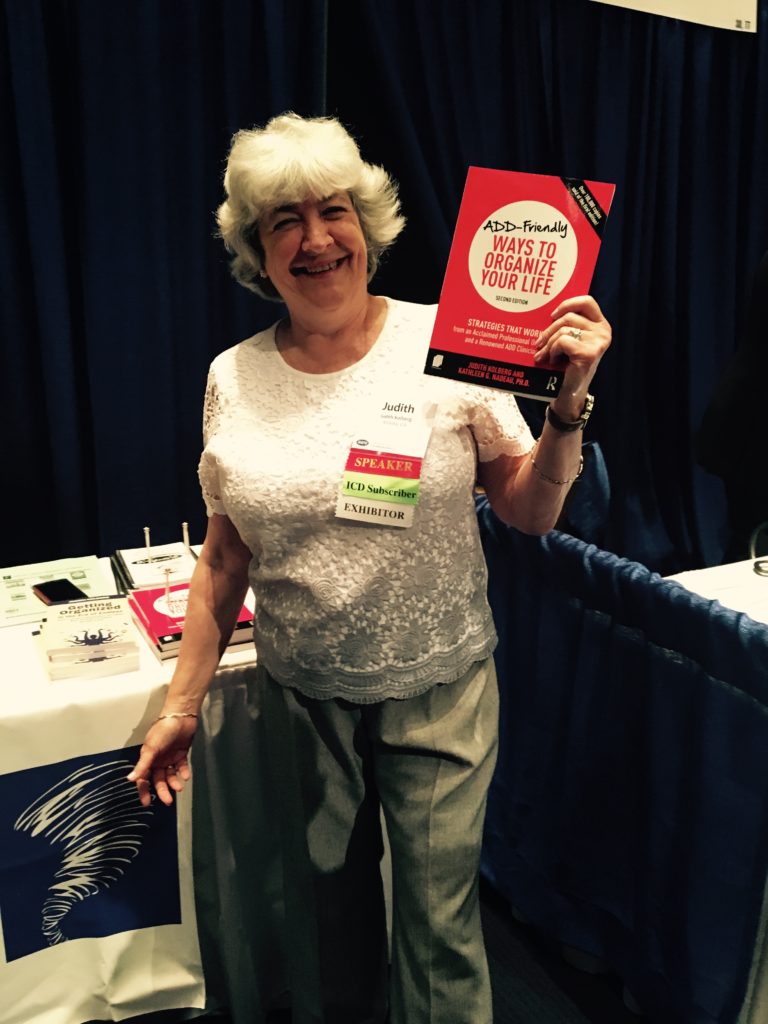
From Judith, we learned how to ease the burdens of grieving families and survivors by eliminating laborious and time-consuming decluttering, identifying essential documents, and providing expertise about local resources. From creating a plan with the executors, to clearing clutter, to helping with the disbursal of possessions, Judith provided a wealth of expertise and strategies for organizing those who have gone on to their reward.
The next day of the conference saw me focusing on technology and productivity, two intertwined topics. I began with Nine Technology Tools to Skyrocket Productivity, presented by the twin geniuses friend-of-the-blog Brooks Duncan and fancy-shoe-wearing Amy Payne, CPO®.
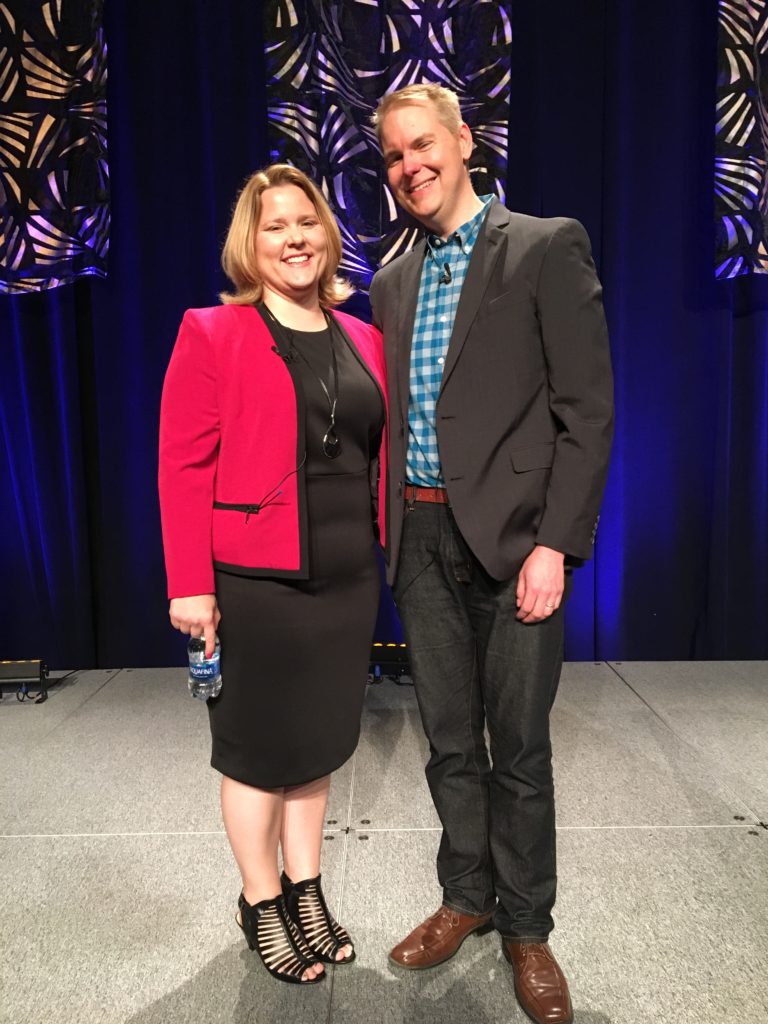
From tools for maintaining contact with, and organizing information about, our current and prospective clients and vendors, to password management software, to text expansion tools for saving yourself the headache of writing the same phrases millions of times, this session was a gem. (And I’ll be sharing some deeps secrets they imparted over the coming weeks.) There were well-beloved tools like Evernote (which I used to prepare my conference posts), and Hazel (automated organization software for Mac about which I’ve heard Brooks talk for years but haven’t yet managed to start using). But there were also surprises, like “quick capture” video tools Jing and Snagit (I usually use Quickcast), and a fascinating diagram/flowchart-maker called LucidChart. I’m giving myself the advice I’d give clients, and blocking time on my schedule this month to learn how these newer tools can help me help my clients.
In the afternoon, I was excited to finally meet podcaster and productivity coach Zachary Sexton in person after so many tweets. His session on being Busily Unproductive was like a personalized coaching session crossed with a refresher course in counteracting the unproductive “stuck” feeling we often face. I left this session with a brainstormed (and now, prioritized) list of things that will move me forward toward my goals.

By Saturday morning, I was ready for a deep dive into psychology, and nobody shares knowledge about ADHD better than Dr. Ari Tuckman, author of More Attention, Less Deficit, and whose repeat performances at our NAPO conference are the stuff of legend.
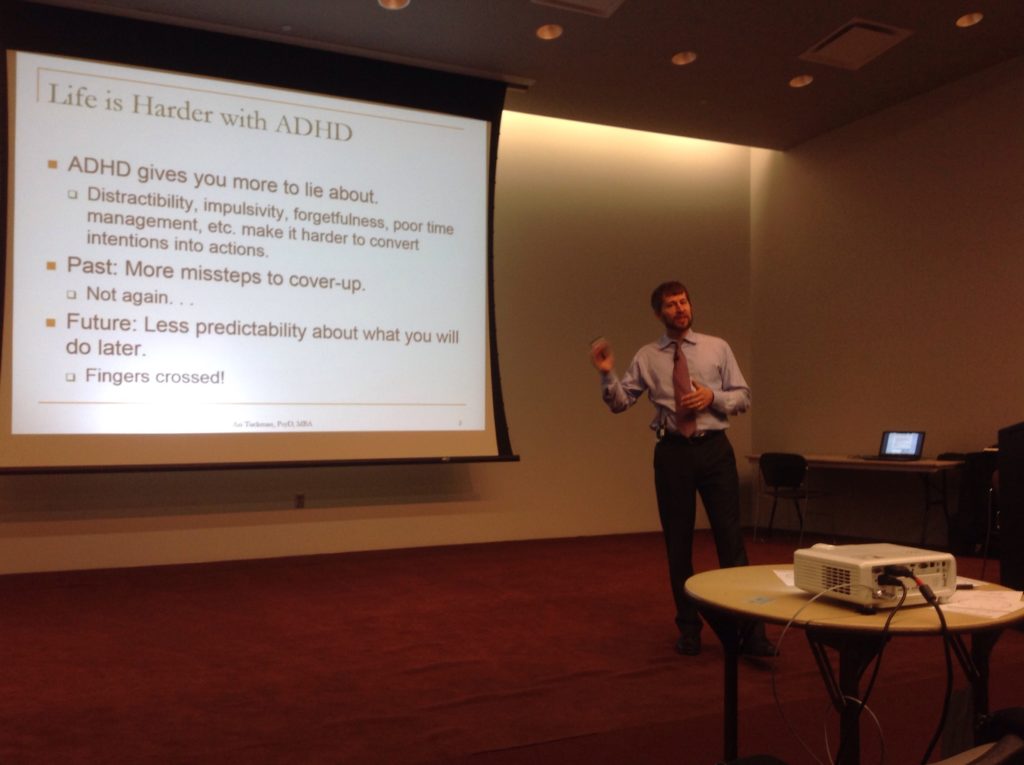
This year, Dr. Tuckman spoke on What Are Your Clients’ Favorite Lies? — and anyone who has ADHD (and many of us who don’t) will recognize the falsehoods we tell ourselves, from “This will just take a minute,” to “I don’t need to write that down — I’ll remember it!” Dr. Tuckman walked us through strategies to help all of us understand and defend against these mindsets.
To close out the major educational sessions, my friend and Nashville colleague Liz Jenkins, just up the road from Paper Doll HQ in Chattanooga, shared Beyond the Label Maker: Tools of the Trade. Unfortunately, Liz moves so quickly around the stage, that the adorable shot of her trying on a headlamp for our amusement is just a blur — perhaps she’s a superhero? — but here’s Liz, on the left, with LA’s John Trosko and New York City’s Amy Neiman.
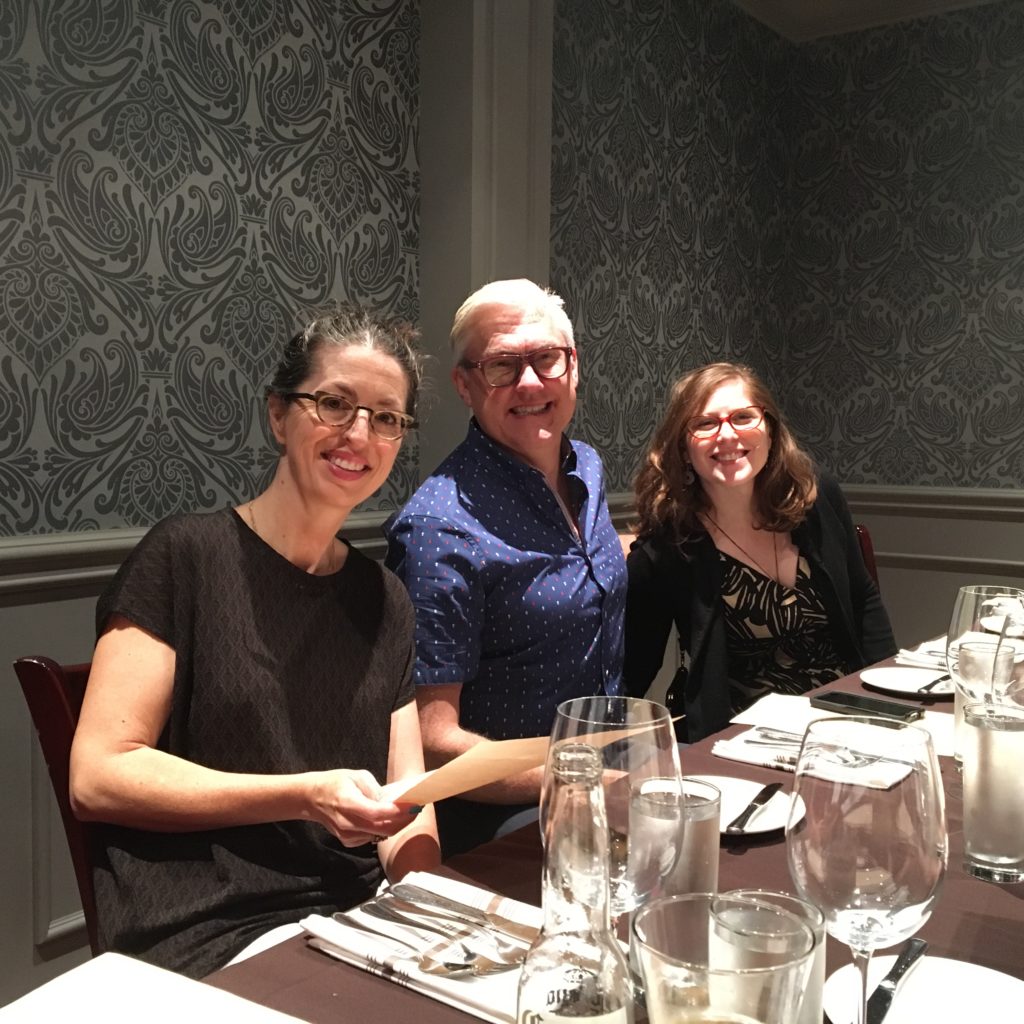
After 15+ years in the business of organizing, it may be surprising but there’s still a wealth of resources (and tactics) to be learned from our colleagues and the way they organize, but Liz floored us with her “BoBs” (kits) of essentials. And now I’ve learned about Zott’s adhesive dots.
EXTRA CREDIT MATERIAL
In addition to formal educational sessions, our conference attendees heard a keynote from Jones Loflin entitled Grow, Cultivate, Prune and Harvest: How to Blossom Even in Times of Change. (And who among us doesn’t struggle with change? I’ve been known to say that I love novelty, but hate change, so I suspect that mean I was ripe for what Jones had to share. Meanwhile, organizing superstar Monica Ricci (my chapter president when I joined NAPO more than fifteen years ago), led two star-studded business leadership panels.
By far the most popular aspect of the conference this year was the addition of three concurrent discussion sessions during which attendees watched TED Talks and delved into the issues in a hearty round-robin of discussion.
- Presidents’ Award-winning NAPOite Hazel Thornton led a presentation on Susan Cain’s The Power of Introverts for a discussion on Networking for Introverts.
- Katie Tracy led a discussion of Amy Cuddy’s Your Body Language Shapes Who You Are (from which you might know about “superpower poses”).
- I attended the Debbie Lillard-moderated presentation on Tim Urban’s Inside the Mind of a Master Procrastinator. It’s one of my favorite TED Talks, and I believe we all have known the Panic Monster and Instant Gratification Monkey. We not only examined the procrastination obstacles our clients face, but became a unified support group in search of strategies for our own issues with putting things off.
NEXT LESSONS
In the upcoming posts, I will be sharing the highlights of the NAPO2017 expo — the most intriguing products and services. Check them out here:
- Paper Doll’s NAPO 2017 Recap: New Twists on Time Timer
- Paper Doll’s NAPO 2017 Recap: Samsill Upgrades Pop N’ Store & Pleases Paper Mommy
- Paper Doll’s NAPO 2017 Recap: A Sneak Peak at Smead’s All-in-One® Organizer Kits
I’d like to leave you with two thoughts.
First, thousands of professional organizers around the world commit to expanding our education and expertise so that we can help our clients reach their goals. Whether our clients are new parents or students or office managers, people with ADHD or physical disabilities or anxiety, or those seeking to straighten out their homes or workspaces or their tasks or their thoughts, there are professional organizers working to learn and grow to help them. If you or someone you know would like to be more organized or productive, please visit NAPO’s provider search tool.
Second, Paper Doll has been covering NAPO conferences for a long time. Just type “NAPO Conference” into the search box on the left side of the blog, and you’ll have quite the organizing adventure.




Follow Me